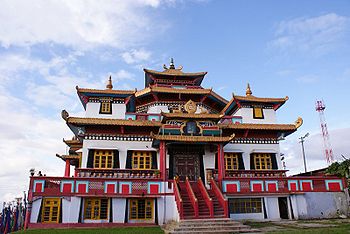Zangdokpalri Monastery: Difference between revisions
Yeshedorje (talk | contribs) mNo edit summary |
Yeshedorje (talk | contribs) mNo edit summary |
||
| Line 14: | Line 14: | ||
==Recent Years== | ==Recent Years== | ||
Zangdokpalri Monastery is now run since 2009 by a young [[tulku]], Shingdrup Rinpoche. | Zangdokpalri Monastery is now run since 2009 by a young [[tulku]], Shingdrup Rinpoche. | ||
==Main Characters== | |||
For many years since its founding by Dudjom Rinpoche, the Zangdokplari Monastery was run by four ngakpas: | |||
*[[Lama Chime Rinpoche]] (1920—2012) | |||
*Lama Darkten (?-?) | |||
*Lama Tsarak Gonpo Tenzing (1920-2015) | |||
*Lama Jangchub Rinpoche (b.?) | |||
==Notes== | ==Notes== | ||
Revision as of 07:34, 20 April 2017

Zangdokpalri Monastery[1] is a Nyingma monastery established by Dudjom Rinpoche in Kalimpong, West Bengal, India, as early as 1946[2].
Origins
Before the political events in Tibet in the 1950’s, Kalimpong, a north-eastern city of India, close to the Sikkim border, was a prosperous city and a key milestone for pilgrims and merchants on the road to Lhasa. The monastery was built by Dudjom Rinpoche in 1946, during one of his early stays in India.
Description
The monastery is located atop Durpin Hill, one of the two hills of the town, and oversees the city with a breathtaking view. The architecture is modeled on the palace of Guru Rinpoche in Zangdokpalri. The monastery houses many rare scriptures that were brought into India after the invasion of Tibet in 1959.
Developments
The monastery was consecrated by the Dalai Lama in 1976. The shedra, founded in 1983, has approximately 60 students. The monastery is the residence of Lama Chime Rinpoche, a senior student of Dudjom Rinpoche.
Recent Years
Zangdokpalri Monastery is now run since 2009 by a young tulku, Shingdrup Rinpoche.
Main Characters
For many years since its founding by Dudjom Rinpoche, the Zangdokplari Monastery was run by four ngakpas:
- Lama Chime Rinpoche (1920—2012)
- Lama Darkten (?-?)
- Lama Tsarak Gonpo Tenzing (1920-2015)
- Lama Jangchub Rinpoche (b.?)